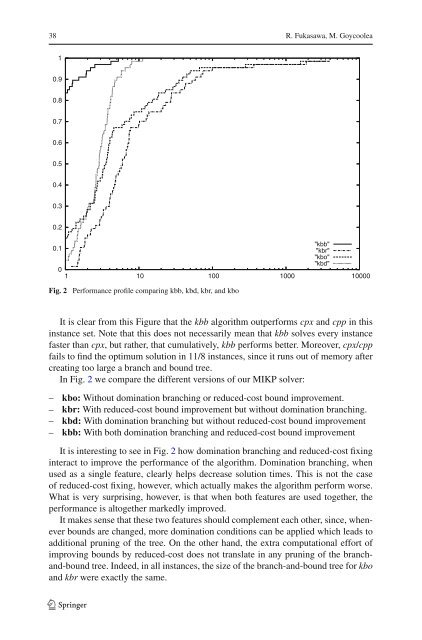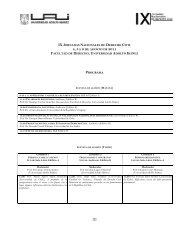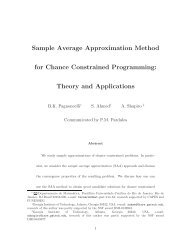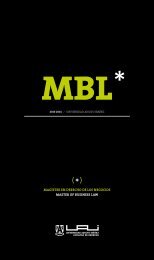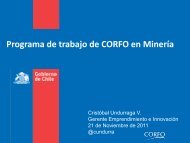38 R. Fukasawa, M. Goycoolea10.90.80.70.60.50.40.30.20.101 10 100 1000 10000Fig. 2 Performance pr<strong>of</strong>ile comparing kbb, kbd, kbr, and kboIt is clear from this Figure that <strong>the</strong> kbb algorithm outperforms cpx and cpp in thisinstance set. Note that this does not necessarily mean that kbb solves every instancefaster than cpx, but ra<strong>the</strong>r, that cumulatively, kbb performs better. Moreover, cpx/cppfails to find <strong>the</strong> optimum solution in 11/8 instances, since it runs out <strong>of</strong> memory aftercreating too large a branch and bound tree.In Fig. 2 we compare <strong>the</strong> different versions <strong>of</strong> our MIKP solver:– kbo: Without domination branching or reduced-cost bound improvement.– kbr: With reduced-cost bound improvement but without domination branching.– kbd: With domination branching but without reduced-cost bound improvement– kbb: With both domination branching and reduced-cost bound improvementIt is interesting to see in Fig. 2 how domination branching and reduced-cost fixinginteract to improve <strong>the</strong> performance <strong>of</strong> <strong>the</strong> algorithm. Domination branching, whenused as a single feature, clearly helps decrease solution times. This is not <strong>the</strong> case<strong>of</strong> reduced-cost fixing, however, which actually makes <strong>the</strong> algorithm perform worse.What is very surprising, however, is that when both features are used toge<strong>the</strong>r, <strong>the</strong>performance is altoge<strong>the</strong>r markedly improved.It makes sense that <strong>the</strong>se two features should complement each o<strong>the</strong>r, since, wheneverbounds are changed, more domination conditions can be applied which leads toadditional pruning <strong>of</strong> <strong>the</strong> tree. <strong>On</strong> <strong>the</strong> o<strong>the</strong>r hand, <strong>the</strong> extra computational effort <strong>of</strong>improving bounds by reduced-cost does not translate in any pruning <strong>of</strong> <strong>the</strong> branchand-boundtree. Indeed, in all instances, <strong>the</strong> size <strong>of</strong> <strong>the</strong> branch-and-bound tree for kboand kbr were <strong>exact</strong>ly <strong>the</strong> same.123
<strong>On</strong> <strong>the</strong> <strong>exact</strong> <strong>separation</strong> <strong>of</strong> MIK <strong>cuts</strong> 395 Final remarks<strong>On</strong>e <strong>of</strong> <strong>the</strong> goals <strong>of</strong> this study has been to assess <strong>the</strong> overall effectiveness <strong>of</strong> MIRinequalities relative to <strong>knapsack</strong> <strong>cuts</strong>. We observe that in most test problems fromMIPLIB 3.0 and MIPLIB 2003, <strong>the</strong> bound obtained by using just MIR inequalities isvery similar in value (if not equal) to <strong>the</strong> bound obtained using all possible <strong>knapsack</strong><strong>cuts</strong>. This observation helps explain <strong>the</strong> difficulty in outperforming MIRs by usingo<strong>the</strong>r <strong>cuts</strong> from tableau and formulation rows, and suggests that for fur<strong>the</strong>r boundimprovements on this instance set we might have to consider new row aggregationschemes, or <strong>cuts</strong> derived from multiple row systems. We would like to point out, however,that it may still be possible to obtain a significant improvement on <strong>the</strong> practicalperformance <strong>of</strong> MIR inequalities using o<strong>the</strong>r <strong>knapsack</strong> <strong>cuts</strong>, for instance if <strong>the</strong> performanceis measured in terms <strong>of</strong> total time it takes to reach a similar gap level.We put great care into ensuring that <strong>the</strong> generated <strong>cuts</strong> are valid and that <strong>the</strong> procedureruns correctly, but this makes <strong>the</strong> methodology very slow. For example, some <strong>of</strong><strong>the</strong> unsolved instances ran for over a week without a final answer being reported. Part<strong>of</strong> <strong>the</strong> difficulty arises from <strong>the</strong> fact that <strong>exact</strong> arithmetic is being employed. We haveobserved that on <strong>the</strong> average performing <strong>exact</strong> arithmetic computations takes severalorders <strong>of</strong> magnitudes longer than floating-point computations.As a final remark, we note that recently, <strong>knapsack</strong> <strong>cuts</strong> have been used in practiceto help solve some combinatorial optimization problems [7]. Following up on this, itwould be interesting to see if we can also use our <strong>knapsack</strong> cut generation procedurein practice to help solve some classes <strong>of</strong> <strong>mixed</strong> <strong>integer</strong> programming problems.Acknowledgments The authors would like to thank William J. Cook for his support and encouragementin doing this work. They are also grateful to Sanjeeb Dash and Oktay Günlük for hosting <strong>the</strong>m at <strong>the</strong> IBMT.J. Watson Research Center as student interns during <strong>the</strong> summers <strong>of</strong> 2004 and 2006. The discussions andquestions raised during <strong>the</strong>se internships were key factors in motivating this research.References1. Achterberg, T., Koch, T., Martin, A.: MIPLIB 2003. Oper. Res. Lett. 34(4), 1–12 (2006). doi: 10.1016/j.orl.2005.07.009. http://www.zib.de/Publications/abstracts/ZR-05-28/. Seehttp://miplib.zib.de2. Andonov, R., Poirriez, V., Rajopadhye, S.: Unbounded <strong>knapsack</strong> problem: dynamic programmingrevisited. Eur. J. Oper. Res. 123, 394–407 (2000)3. Applegate, D., Bixby, R.E., Chvátal, V., Cook, W.: TSP <strong>cuts</strong> which do not conform to <strong>the</strong> template paradigm.In: Computational Combinatorial Optimization, Optimal or Provably Near-Optimal Solutions[based on a Spring School], pp. 261–304. Springer-Verlag GmbH, London (2001)4. Applegate, D., Cook, W., Dash, S., Espinoza, D.: Exact solutions to linear programming problems.Oper. Res. Lett. 35, 693–699 (2007)5. Atamtürk, A.: <strong>On</strong> <strong>the</strong> facets <strong>of</strong> <strong>the</strong> <strong>mixed</strong>–<strong>integer</strong> <strong>knapsack</strong> polyhedron. Math. Program. 98, 145–175(2003)6. Atamtürk, A.: Sequence independent lifting for <strong>mixed</strong>–<strong>integer</strong> programming. Oper. Res. 52, 487–490(2004)7. Avella, P., Boccia, M., Vasilyev, I.: A computational study <strong>of</strong> <strong>exact</strong> <strong>knapsack</strong> <strong>separation</strong> for <strong>the</strong> generalizedassignment problem. Technical report available at Optimization <strong>On</strong>line (2006)8. Balas, E., Perregaard, M.: A precise correspondence between lift-and-project <strong>cuts</strong>, simple disjuntive<strong>cuts</strong>, and <strong>mixed</strong> <strong>integer</strong> Gomory <strong>cuts</strong> for 0–1 programming. Math. Program. 94, 221–245 (2003)9. Balas, E., Saxena, A.: Optimizing over <strong>the</strong> split closure. Math. Program. 113(2), 219–240 (2008)10. Balas, E., Zemel, E.: Facets <strong>of</strong> <strong>knapsack</strong> polytope from minimal covers. SIAM J. Appl. Math.34(1), 119–148 (1978)123


